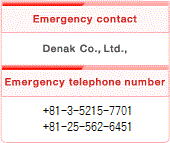Measures when leakage and fire occur
Leakage
- Always wear protective equipment and ensure that the product does not directly contact the eyes and skin.
(MCA flake products, SMCA)
Use of water is prohibited. Scatter sodium bicarbonate and use a dry clean-up method. Avoid the generated dust. Place the mixture of recovered flakes and sodium bicarbonate in an airtight polyethylene or polypropylene container.
(Aqueous solution)
Prevent emptying the solution into waters including rivers. Neutralize the solution with sodium bicarbonate to pH=`7. (It is important to confirm the pH with tests such as with litmus paper, and then dispose or recover.)
| Neutralizing agent at recovery | Sodium bicarbonate, sodium carbonate, calcium hydroxide, and magnesium lime |
|---|
Fire
Measures when fire occurs
- For extinguishing fire, use alcohol resistant foam, carbon dioxide gas, and powder-type fire extinguishing media. Do not use water for fire extinguishing.
- * If fire or explosion occurs, wear respiratory protective equipment and acid-resistant clothes to avoid contact with skin and eyes. Extinguish fire from upwind. (Although this product does not flash or ignite easily, it produces hazardous gas and irritating gas when it burns.)
- If water spraying is performed to prevent the spread of fire, avoid spraying water on the product. After the fire is extinguished, do not discharge cooling water on the product.
Prevention of secondary damage from aqueous solution
Do not use Kevlar fire-fighting gloves because water penetrates the gloves.
Precautions for transporting
Monochloroacetic acid
International regulations
| IMDG Code (International Maritime Dangerous Goods Code) |
Class 6.1, subsidiary risk class 8 Packing group II |
|---|---|
| ICAO-TI (International Civil Aviation Organization -Technical Instructions) /IATA-DGR (International Air Transport Association -Dangerous Goods Regulations) |
Class 6.1, subsidiary risk class 8 Packing group II |
| United Nations Classification | Group 6.1, subsidiary risk class 8 Packing group II |
| United Nations Number | 1751 |
| Product Name (United Nations Shipping Name) |
Monochloroacetic acid (solid) |
|---|---|
| Packing Group | II |
| Marine Pollutant | Not applicable |
| Japanese Regulations | Poisonous and Deleterious Substance Control Law: Article 2, Attachment List No. 2, Deleterious Substance |
| Road Law | Enforcement Ordinance 19-13, Item 1, Poisonous and Deleterious Substances, (Restrictions of Vehicle Passage) |
| Ship Safety Law | Regulations for the Carriage and Storage of Dangerous Goods in Ships: Articles 2, 3, Dangerous Goods Notice Attachment List No. 1, Poisonous Substance Class, Poisonous Substance |
| Specific Safety Measures and Conditions for Transport |
|
Precautions for transporting
Sodium monochloroacetate
International regulations
| IMDG Code (International Maritime Dangerous Goods Code) |
Class 6.1, subsidiary risk class 8 Packing group III |
|---|---|
| ICAO-TI (International Civil Aviation Organization -Technical Instructions) /IATA-DGR (International Air Transport Association -Dangerous Goods Regulations) |
Class 6.1, subsidiary risk class 8 Packing group III |
| United Nations Classification | Group 6.1, subsidiary risk class 8 Packing groupIII |
| United Nations Number | 2659 |
| Japanese Regulations | Poisonous and Deleterious Substance Control Law: Article 2, Attachment List No. 2, Deleterious Substance |
|---|---|
| Road Law | Enforcement Ordinance 19-13, Item 1, Poisonous and Deleterious Substances, (Restrictions of Vehicle Passage) |
| Ship Safety Law | Regulations for the Carriage and Storage of Dangerous Goods in Ships: Articles 2, 3, Dangerous Goods Notice Attachment List No. 1, Poisonous Substance Class, Poisonous Substance |
| Specific Safety Measures and Conditions for Transport |
|
Precautions for transporting
Monochloroacetic acid, 80% aqueous solution
International regulations
| IMDG Code (International Maritime Dangerous Goods Code) |
Class 6.1, subsidiary risk class 8 Packing group II |
|---|---|
| ICAO-TI (International Civil Aviation Organization -Technical Instructions) /IATA-DGR (International Air Transport Association -Dangerous Goods Regulations) |
Class 6.1, subsidiary risk class 8 Packing group II |
| United Nations Classification | Group 6.1, subsidiary risk class 8 Packing group II |
| United Nations Number | 1751 |
| Product Name (United Nations Shipping Name) |
Monochloroacetic acid |
|---|---|
| Packing Group | II |
| Marine Pollutant | Hazardous liquid substance (Class C) |
| Road Law | Enforcement Ordinance 19-13, Item 1, Poisonous and Deleterious Substances, (Restrictions of Vehicle Passage) |
| Ship Safety Law | Regulations for the Carriage and Storage of Dangerous Goods in Ships: Articles 2, 3, Dangerous Goods Notice Attachment List No. 1, Poisonous Substance Class, Poisonous Substance |
| Specific Safety Measures and Conditions for Transport |
|



